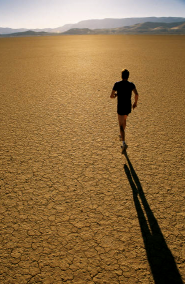Continuing our discussion of marathon issues, here are key guidelines from BJSM Associate Editor Professor Tim Noakes:
10 Recommendations for the Prevention of Heat illness:
1. Perform adequate conditioning. The athlete must have trained appropriately and be conditioned for the planned activity.
2. Undergo acclimatization if competing in unaccustomed heat or humidity.
3. Avoid adverse conditions. Event organizers should ensure that high intensity or endurance events should not take place in adverse conditions of heat or humidity. If events are to occur in hot climates, they should take place in the early morning before conditions deteriorate.
4. Alter training times. Unless trying to acclimatize, the athlete should avoid exercise at the hottest time of the day.
5. Wear appropriate clothing. In hot conditions, athletes should wear a minimal amount of loose-fitting, light-colored clothing. An open weave or mesh top is ideal. Many athletes choose to remove their top during training in hot conditions. This has the advantage of allowing better heat loss from sweating but is counterbalanced by an increased heat gain from the environment.
6. Drink appropriate amounts of fluids before the event. There is no evidence that “dehydration” or that drinking to stay ahead of thirst either before or during exercise plays any role in the prevention of heat illness. Athletes should drink according to thirst before and during exercise and will remain optimally hydrated.
7. There is no evidence that fluid ingestion during exercise can prevent heatstroke in those predisposed to develop the condition. Nor is there any published evidence that dehydration is an important factor predisposing to heatstroke or the development of illness in athletes who have some access to such fluids during exercise. Fluid ingestion during exercise in the laboratory may reduce the rectal temperature somewhat but that this effect may be a result of the inadequate convective cooling usually present in indoor exercise. When exercise is undertaken in the laboratory in environmental conditions that reproduce the conditions in out-of-door exercise, high rates of fluid ingestion are not required to prevent this additional increase in rectal temperature. Rather, drinking to the dictates of thirst (ad libitum) produces an optimum result.
8. To minimize the uncomfortable sensations of thirst and so to optimize performance during exercise, athletes can be assured that they need drink only according to the dictates of their thirst (ad libitum). Usually, rates of ad-libitum fluid ingestion during exercise may vary between 200 and 800 mL per hour; much higher amounts are not uncommon in athletes who develop exercise-associated hyponatremia. Interestingly, elite athletes appear to drink sparingly during exercise, suggesting that superior athletic ability may be associated with a reduced dipsogenic drive during exercise. This would clearly be an advantageous evolutionary adaptation in early human hunter-gathers like the !Kung San who, since they have no access to fluid during hunting, will not be disabled by the development of intolerable thirst and hence have to terminate their hunt prematurely. For exercise up to 1 hour in duration, plain water is appropriate. For exercise lasting longer than 1 hour, a dilute glucose and electrolyte solution should be used . At longer distances and durations it may becomes increasingly necessary also to eat calorie-dense foods according to individual choice.
9. Ensure athletes and officials are well educated. It is important that event organizers, coaches and athletes understand the importance of adequate hydration, the danger of water intoxication, and the need to avoid excessive environmental conditions.
10. Provide proficient medical support. A well-equipped, well-trained medical team should be present at all endurance events occurring in hot or humid conditions.